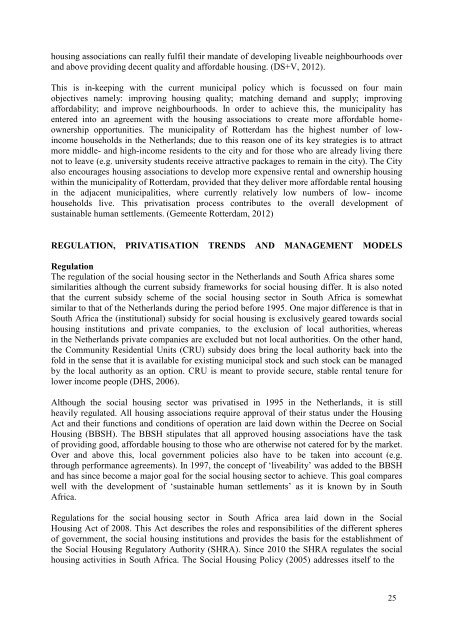ISBN: 978-0-620-54069-8 - Sustainable Human(e) Settlements: The ...
ISBN: 978-0-620-54069-8 - Sustainable Human(e) Settlements: The ...
ISBN: 978-0-620-54069-8 - Sustainable Human(e) Settlements: The ...
Create successful ePaper yourself
Turn your PDF publications into a flip-book with our unique Google optimized e-Paper software.
housing associations can really fulfil their mandate of developing liveable neighbourhoods over<br />
and above providing decent quality and affordable housing. (DS+V, 2012).<br />
This is in-keeping with the current municipal policy which is focussed on four main<br />
objectives namely: improving housing quality; matching demand and supply; improving<br />
affordability; and improve neighbourhoods. In order to achieve this, the municipality has<br />
entered into an agreement with the housing associations to create more affordable homeownership<br />
opportunities. <strong>The</strong> municipality of Rotterdam has the highest number of lowincome<br />
households in the Netherlands; due to this reason one of its key strategies is to attract<br />
more middle- and high-income residents to the city and for those who are already living there<br />
not to leave (e.g. university students receive attractive packages to remain in the city). <strong>The</strong> City<br />
also encourages housing associations to develop more expensive rental and ownership housing<br />
within the municipality of Rotterdam, provided that they deliver more affordable rental housing<br />
in the adjacent municipalities, where currently relatively low numbers of low- income<br />
households live. This privatisation process contributes to the overall development of<br />
sustainable human settlements. (Gemeente Rotterdam, 2012)<br />
REGULATION, PRIVATISATION TRENDS AND MANAGEMENT MODELS<br />
Regulation<br />
<strong>The</strong> regulation of the social housing sector in the Netherlands and South Africa shares some<br />
similarities although the current subsidy frameworks for social housing differ. It is also noted<br />
that the current subsidy scheme of the social housing sector in South Africa is somewhat<br />
similar to that of the Netherlands during the period before 1995. One major difference is that in<br />
South Africa the (institutional) subsidy for social housing is exclusively geared towards social<br />
housing institutions and private companies, to the exclusion of local authorities, whereas<br />
in the Netherlands private companies are excluded but not local authorities. On the other hand,<br />
the Community Residential Units (CRU) subsidy does bring the local authority back into the<br />
fold in the sense that it is available for existing municipal stock and such stock can be managed<br />
by the local authority as an option. CRU is meant to provide secure, stable rental tenure for<br />
lower income people (DHS, 2006).<br />
Although the social housing sector was privatised in 1995 in the Netherlands, it is still<br />
heavily regulated. All housing associations require approval of their status under the Housing<br />
Act and their functions and conditions of operation are laid down within the Decree on Social<br />
Housing (BBSH). <strong>The</strong> BBSH stipulates that all approved housing associations have the task<br />
of providing good, affordable housing to those who are otherwise not catered for by the market.<br />
Over and above this, local government policies also have to be taken into account ( e.g.<br />
through performance agreements). In 1997, the concept of ‘liveability’ was added to the BBSH<br />
and has since become a major goal for the social housing sector to achieve. This goal compares<br />
well with the development of ‘sustainable human settlements’ as it is known by in South<br />
Africa.<br />
Regulations for the social housing sector in South Africa area laid down in the Social<br />
Housing Act of 2008. This Act describes the roles and responsibilities of the different spheres<br />
of government, the social housing institutions and provides the basis for the establishment of<br />
the Social Housing Regulatory Authority (SHRA). Since 2010 the SHRA regulates the social<br />
housing activities in South Africa. <strong>The</strong> Social Housing Policy (2005) addresses itself to the<br />
25


